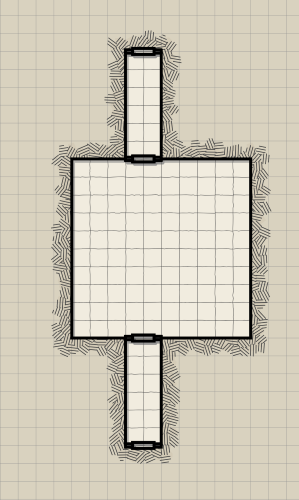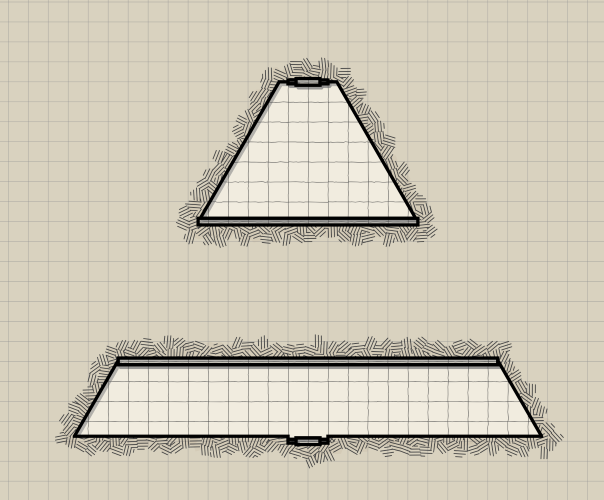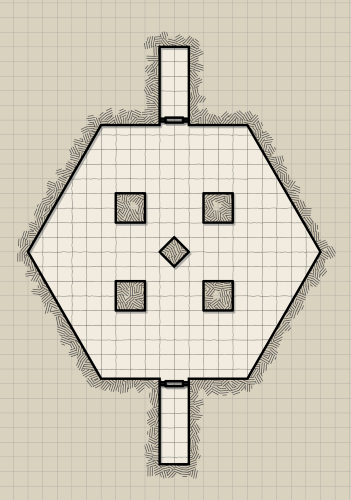My first real foray into designing my own encounter in D&D.
I’ve been learning to be a dungeon master (DM) for D&D 5e over the past few years, mainly thanks to the tireless tutelage of my wife. With the onset of the COVID-19 pandemic, we started a new session with her family, and I was chosen to act as the DM for the campaign! It was my first solo experience, but thankfully they selected a very well written and commonly used starter adventure, The Dragon of Icespire Peak. So, I had some great background material to start with.
As the party slowly developed and found its own style, we quickly realized that this party would try, against all odds, to find a peaceful solution to all encounters. A couple of lucky natural 20 rolls when negotiating with a manticore early on in the game solidified this idea. Seriously, they convinced the manticore that one of our party members was his long lost master, who was very displeased with his behavior.
Eventually, they found their way to a farmhouse that has been overrun by orcs. In the book, it literally says “the orcs are not expecting trouble, but they fight to the death.” Hrm… how are we going to handle this one?
Though some sheer, dumb luck, the party was able to entreat with one of the orcs long enough to convince it that they might be able to help them out. (Ok, this is out of canon, but it works - just hear me out!) A bit of negotiation ensues, and we are off to visit the leader of the orc tribe!
My thought process after that session: Uh oh! That’s not in the book. Well, guess I better come up with something…
I pretty quickly knew that I wanted there to be some way that our party could impress the orc tribe leader, so I pretty quickly settled on some sort of a trial of skill. But, I wasn’t sure what skills to test, nor how to make it seem authentic to the story.
Enter the orc deity Luthic. Instead of the focus on sheer strength and chaos of most orcs, maybe a devoted follower of Luthic would find value in other traits such as intelligence, bravery, and courage? That just might work!
So, I set about coming up with some trials. After some investigation rolls online, I came up with four trials. So, below are my rough notes for how this encounter works and each of the trials. Feel free to use and adapt!
Setting: Orc Tribe
The party enters a cave and encounters Ghorzia, a large and intimidating female orc. She proceeds to give the party some exposition about the makeup of her tribe.
They do not follow the teachings of Gruumsh, who values chaos and destruction in the world above all else. Instead, they are followers of Luthic, the mate of Gruumsh. They believe in maintaining the cohesion of orcish society, that there needs to be some thought behind the chaos in order for it to truly succeed and the gods to be pleased. The strong woman standing behind the man, so to speak.
Recently many of the other tribes were forced from their homes in the mountains (in this case, by the titular Dragon of Icespire Peak). This tribe took the lost bands in and offered to help them find new places where they could live. However, now that those bands are constantly threatening humans, they are afraid that Neverwinter will send troops to quell them. While the males want a fight, this tribe knows it would be suicidal, and they want to find a way to fix this to rebuild their numbers.
Long ago they discovered this magical cave full of mysteries, and their greatest leaders proved themselves by entering and completing the trials. All males who try come back humiliated and ashamed. If the party can prove their worth by completing the trials, she’ll listen to your request. She has very little confidence that the party will succeed.
I took some loose inspiration from the Aes Sedai and Aiel trials in Wheel of Time, among others, for this part.
The Trials
The trials themselves begin with the party entering a mysterious opening in the cave. Ghorzia explains that there are only two ways out, back through this entry, indicating failure, and through a nearby cave, indicating success. While the party may experience a long stretch of time within the trials, barely any time will elapse between the time they enter and the time they exit, either in triumph or defeat. A perceptive party member might use this to infer that the tests themselves take place within a pocket plane, which is a good way to think about it.
When the party steps inside the entry, they are blinded by white light that slowly fades into darkness, and then the darkness gives way slowly to bright light once again, and then the light dims, leaving the party with a clear view of a short stone hallway.
The First Trial

The party is in a stone hallway, 10 feet wide and 10 feet tall. The stone is well fitted, leaving no visible cracks or gaps. There are torches placed along the wall, high toward the ceiling, providing ample light. The party begins at the end of the hallway near a shut door. Leaving through that door will return the party back to the cave in defeat.
At the far end of the hallway, on the wall to the party’s left, there is an inscription repeated in several languages. Players who know many languages would realize that each inscription provides the same information, such that this was meant to be accessible to a wide range of people.
The inscription reads:
Strike this fork upon the ground
Many times it will echo round
Different squares hear a different beat
Find which tiles house defeat
On the other wall hangs a very large tuning fork, nearly 2 feet in length. It is hanging from a very ornate hook, and when the party lifts the fork from the hook, the door in front of them will open, revealing the next room. That door cannot be opened by any other means, and will close again if the tuning fork is placed back on the hook.
The room that it opens to is 50 feet by 50 feet, or 10 by 10 squares. The ceiling is very tall, 20 feet or more, and once again there are a large number of torches providing ample light. However, the party should quickly notice that there are four torches above the center of the room that burn with what appears to be a magical color. Something is maintaining that fire beyond just burning wood and oil.
This room is set up to mimic the classic Minesweeper game. There are several squares with magical traps that are hidden, which can only be detected by the tuning fork. By tapping the tuning fork on the floor, it will make a distinct sound (or number of sounds) indicating the number of traps adjacent to that tile. Each time a trap is triggered, something from the Totally Random Magical Effects Table is employed, and one of the magical torches burns out. After four traps are triggered, the party is teleported back to the beginning the trial, and the room is reset (but the magical effects may linger).
After reaching the other side, the players can continue on to the second trial.
See the sources and inspiration links below for additional resources and tools to help build this trial. It requires at least some prior setup to have the maps ready to go.
The Second Trial

The second trial puts the party into a long, narrow hallway. The ceiling is pretty low (only 10 feet or so), but there is ample lighting to see the way. In the distance, the party sees another door, looking identical to the one they just came through. As soon as the entire party enters the hallway, the door behind them magically shuts with a click.
On the wall, the players will find another inscription similar to the last, written in several languages that all say the same thing:
The door is shut, the path is blocked
Only with the key may it be unlocked
Some quick investigation checks by the party will reveal what appears to be a hook nearby that holds a key. So, presumably, the party will progress down the hallway and open the door. It leads back to what appears to be an identical hallway. As before, once the entire party is through the door, it shuts with a click.
This time, however, if the party stops to read the inscription, they’ll see that it now contains a second stanza:
The door is shut, the path is blocked
Only with the key may it be unlocked
The way forward is the most direct
But is another way more correct?
With a bit of thinking, the party should realize that the only correct way out of this maze is back the way they came. Sure enough, by unlocking the door they just came through (after it has closed), they’ll find that it opens to an entirely different area, and the trial is complete.
As a DM, you can be as vague and mysterious as you want with this one. Hopefully the party doesn’t just keep plowing ahead without turning back, but if they do, have patience and let them. You want to make sure they are the ones that get burned out, not you!
The Third Trial

As the party exits the narrow hallway, they’ll find themselves at the south end of this room - what appears to be a triangular shape with a large, 35 foot gap between the platform where the party stands and the obvious exit on the other side. The floor is covered in sand, but the walls themselves are perfectly smooth and the ceiling seems to be extraordinarily high. The pit under the gap is deep and dark, and appears to be at least a 50 foot drop - enough to cause serious damage, but probably not enough to be instantly fatal.
As before, an inscription on the wall will give some instructions:
A leader must lead into the unknown
With grit sent forth, a way is shown
With a bit of thinking, hopefully the party will realize that this is pretty obvious - there is a hidden path between the two platforms that can be revealed by sprinkling sand over it. (I was told after this session that this trial is pretty trope-y, but hey, it’s still fun!) Once the party reaches the other side, they can proceed to the next area.
If a player falls in the pit, give them an appropriate amount of damage. On the south side of the pit are some handholds carved into the stone - enough to allow players to climb back up to the south platform with a minimally difficult acrobatics check.
The Fourth Trial

The fourth and final trial takes place in an hexagonal room. The floor is once again covered in sand, and there are shafts of light coming through small holes in a domed ceiling very high above. In the middle of the room sets an open-topped hourglass on a pedestal, which looks just like a glass funnel. On the ground near the pedestal is a small scoop, capable of refilling the hourglass. with sand from the floor.
Surrounding the hourglass are four massive stone figures that look like iron golems (or appropriately scary adversaries for the party). They stand solemnly at attention, but otherwise look just like massive stone statues.
As soon as the party enters the room, they notice that the sand starts slowly draining out of the hourglass. A quick look would estimate that it takes around 2 minutes to empty the entire thing, so time will pass pretty quickly. On the pedestal below the hourglass, the party finds the following inscription:
Time is passing without end
Do you need more time to spend?
Refilling the glass brings some relief
But cheating time only causes grief
There are times to think and prepare
And times to bring your courage to bear
The future is unknown, yet must be faced
Don’t let your resolve go to waste!
As soon as the party has been given the room description and heard the inscription, I quietly started a 2 minute time and set it on the table where everyone could see it. As the timer counted down, while the party was discussing what to do next, I would interrupt and describe how parts of the statues were slowly breaking off, revealing the gleaming metal of the iron golems contains within. The idea is to add some urgency to any discussions taking place.
Of course, the party could choose to refill the hourglass. If they do so, I reset the timer and describe that the statues are quickly restored to their former state, but then they slowly start to deteriorate once more.
This can continue for several minutes, but eventually the party should come to the conclusion that there is nothing more to be done in the room - they must simply let the hourglass empty and face the horrors of multiple deadly enemies at once. They could of course choose to attack them while they are still encased in stone, but it will only quicken their release. If one of the enemies is released, it should attack the party ruthlessly while the timer is still running.
If the timer is allowed to expire, the golems will cease any movement and simply salute the party. The exit door will open, and the party will be allowed to leave the trial. It is simply a trial of bravery and (hopefully) quick decision making.
The Aftermath
Once the party emerges from the trials, they’ll notice that nearly no time has passed. They’ll find Ghorzia waiting for them, with a mildly surprised look on her face. If they are successful, she’ll order a large feast to be prepared in their honor, and afterwards she will be willing to talk and make a deal with the party.
Of course, if the party fails the trials and exits in disgrace, Ghorzia will kindly but firmly see that they depart the mountains soon, with instructions to not seek them out again.
Overall, this made for an amazing session, and fit well with the party I was hosting. They were generally looking to avoid combat and instead find peaceful, non-violent ways to solve their problems, and puzzles such as this proved to be a great way for them to explore teamwork and use their skills outside of combat.
Sources and Inspirations
- The Dragon of Icespire Peak - Original Campaign Source
- Your Campaign Setting Needs Orcs - Where I Learned About Luthic
- Luthic - More Info on Luthic
- Tangerhino on Reddit - Two Trials Inspired Here
- Totally Random Magical Effects Table - What Happens if you Miss?
- HeyThisIsBrian on Reddit - Trapsweeper!
- Discord Minesweeper Generator - Map Maker for Minesweeper
- Dungeon Scrawl - Best Map Creation Tool Ever!
roll for initiative!